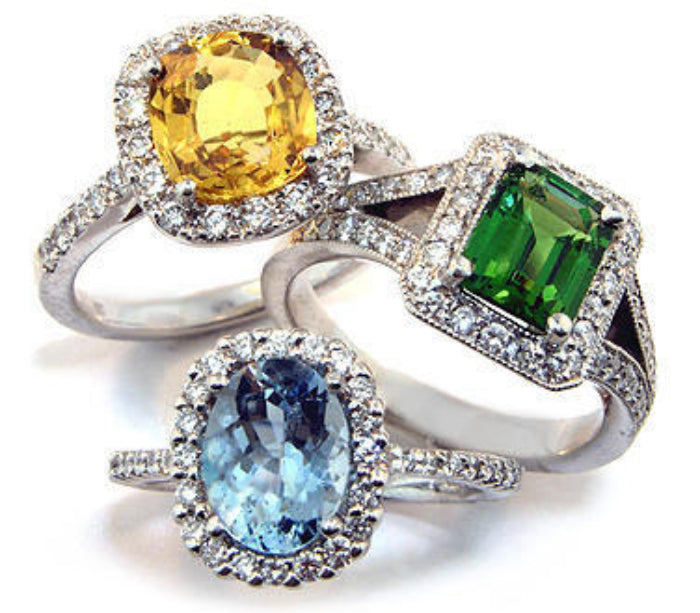
Gemstone Education
Sedimentary gemstone creation occurs when water mixes with mineral on the earth’s surface. The mineral-rich water seeps down between the cracks and cavities in the earth and deposits layers of minerals. This is how minerals like Opal, Malachite and Azurite are formed. Opal is formed when the water mixes with silica. Jan 30, 2017. Jewelry Gemstone Education will make us learn more.
Jewelry Gemstone Education
4Cs OF GEMSTONES
Gemstone Color (Hue-tone-saturation)
When impurities are added to colorless gemstones, brilliant colors are frequently produced. When chromium is added to colorless corundum, red ruby is born, and a green emerald emerges when chromium is added to colorless beryl. Diamonds can be colored blue or yellow by the addition of impurities.
Gemstone Cut
While some cut names may describe the face-up shape of the finished gem, others refer to the shape and arrangement of the gem’s facets. These cuts are also known as gem cutting styles. The three most basic cutting styles are brilliant, step, and mixed. For example, a “round brilliant diamond” has a round shape but a brilliant cutting style. Factors can combine these styles to create many different gem designs.
Gemstone Clarity
The scale was created specifically for grading diamonds, more specifically, white diamonds — not colored gemstones. For colored gemstones, it is difficult to use a ‘one size fits all’ classification system for clarity, since some colored gemstones are expected to have inclusions and are sometimes even identified by their inclusions. For example, the inclusions of emerald often provide evidence that it is natural. Additionally, some inclusions are desirable, such as ‘horsetail inclusions’ in demantoid garnet and rutile ‘silk’ in sapphire.
Gemstone Carat Weight (Size)
Carat refers to the measure of the gemstone. Different types of stones will possess particular densities (mass per unit amount), therefore two gems visually looking identical in size may differ in weights. For instance, a diamond is less dense than a ruby, for this reason, a 1-carat diamond will look bigger than a 1-carat ruby.
Diamond Color
Emerald
The emerald is a colored gemstone that is found in various shades of green, deriving its name from the Greek word “smaragdos’ which means green stone. To be considered a top gem, an emerald must possess a pure green hue and a high degree of transparency (crystal). Traditionally emeralds were worn to promote healing and enhance love and contentment. Its rich shades of green bring to mind feelings of rejuvenation and new beginnings. Colombia has become the leading source of emeralds for the past couple of centuries.
Sapphire
The sapphire is a colored gemstone named after the Hebrew and Arabic root word “safir” meaning blue. This precious gemstone is most often thought of as only being blue, however, “fancy colored sapphires”, as they are called, can be found in almost every color of the rainbow. The cost of natural sapphires will vary depending on their color, clarity, size, cut, and overall quality with the most sought-after ones being of the cornflower blue variety. Many kings of yesteryear were known to wear sapphires as a powerful defense from harm. These gems were thought to have healing powers and to attract divine favor.
Ruby
Jewelry Gemstone Education
The ruby draws its name from the Latin word “rubber” meaning the red color of passion. This colored gemstone ranges from pink to deep red and its price is determined by color, clarity, size, cut, and overall quality. The brightest and most valuable “red” ruby is called pigeon blood-red. Similar to diamonds, rubies have natural imperfections in them known as “silk”. Since ancient times, rubies have been adorned by royalty and it is said that a good quality ruby will bring its owner a life of peace and harmony. Burma is a Southeast Asian country renowned for producing some of the highest quality rubies on Earth.
Black Diamond
Classified as a precious stone, natural black diamonds are entirely opaque and this is what differs them from most diamonds. They are considered quite valuable since they are stunningly beautiful and considered very precious. They are still, however, more affordable in comparison with other colored diamonds.
There are contradictory myths and beliefs when it comes to black diamonds and what they represent. According to the Indian legend, they represent Yama, the god of death. The Italian belief, however, is almost in direct opposition, stating that this is the stone of reconciliation – so it is believed the black diamond can help with tying loose ends in a relationship and making it work.
Carat – The carat is the unit of weight by which a diamond is measured. The price difference among different sellers is a result of various reasons, for example naturally mined black diamonds would be more expensive but still a cheaper alternative than diamonds in another color. The black ones are often harder to polish and that may affect the cut.
Cut – Naturally mined black diamonds do indeed look very rough so they need to be shaped using various methods, and this process is called cutting or polishing. This is done with the help of a thin toothless circular saw blade and the action of “cutting” is performed by the diamond dust with which the blade itself was impregnated with.
Clarity – The clarity of a stone indicates the number of flaws or inclusions present in the diamond, but when it comes to Black Diamonds, it is not as important as they do not refract light as much as the other diamonds.
Color – Natural black diamonds can be found in the rough with this exact same black color, which results in them being extremely popular, due to the rarity of their color. They owe their color to the graphite which formed in the crystalline structure during the diamond’s formation. Naturally, they only come in one color-intensity, Fancy Black.








